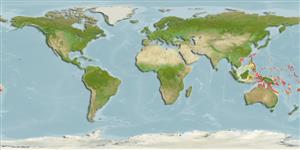Klassifizierung / Names
Namen | Synonyme | Catalog of Fishes(Gattung, Arten) | ITIS | CoL | WoRMS | Cloffa
>
Gobiiformes (Gobies) >
Gobiidae (Gobies) > Gobiinae
Etymology: Ctenogobiops: Greek, kteis, ktenos = comb + Latin, gobius = gudgeon + Greek, ops = appearance (Ref. 45335); mitodes: Name from Greek 'mitodes' meaning theadlike, refers to the filamentous 2nd dorsal spine of adults..
More on authors: Randall, Shao & Chen.
Environment: milieu / climate zone / depth range / distribution range
Ökologie
seewasser riff-verbunden; tiefenbereich 9 - 21 m (Ref. 75863). Tropical
Western Pacific.
Size / Gewicht / Alter
Maturity: Lm ? range ? - ? cm
Max length : 5.3 cm SL Männchen/unbestimmt; (Ref. 75863)
Kurzbeschreibung
Bestimmungsschlüssel | Morphologie | Morphometrie
Rückenflossenstacheln (insgesamt) : 6 - 7; Rückenflossenweichstrahlen (insgesamt) : 11; Afterflossenstacheln: 1; Afterflossenweichstrahlen: 11. Characterized by whitish body color with four longitudinal rows of dark brown spots (midlateral row spots largest and horizontally elongate); large anterior dark spots of midlateral row often encircled by blue dots; cheeks with row of three dark spots; behind lower edge of eye with oblique blue and yellow mark followed by similar marks on opercle and preopercle; curved blue and yellow line/dashes from behind upper eye to below of dorsal fin origin; lower part of pectoral fin with elliptical white spot; longitudinal scale series 52-56; opening of gill extending slightly anterior to vertical at posterior edge of preopercle; greatest depth of body 4.3-5.0 in SL; rounded caudal fin, shorter than length of head (Ref. 90102).
Collected by rotenone and spear from silty, sand and rubble bottoms (Ref. 75863). Also found in lagoons (Ref 90102).
Life cycle and mating behavior
Maturities | Fortpflanzung | Spawnings | Egg(s) | Fecundities | Larven
Randall, J.E., K.-T. Shao and J.-P. Chen, 2007. Two new shrimp gobies of the genus Ctenogobiops (Perciformes: Gobiidae), from the Western Pacific. Zool. Stud. 46(1):26-34. (Ref. 75863)
IUCN Rote Liste Status (Ref. 130435)
Bedrohung für Menschen
Harmless
Nutzung durch Menschen
Tools
Zusatzinformationen
Download XML
Internet Quellen
Estimates based on models
Preferred temperature (Ref.
123201): 25.6 - 29.3, mean 28.5 °C (based on 1064 cells).
Phylogenetic diversity index (Ref.
82804): PD
50 = 0.5020 [Uniqueness, from 0.5 = low to 2.0 = high].
Bayesian length-weight: a=0.00708 (0.00333 - 0.01504), b=3.09 (2.92 - 3.26), in cm total length, based on LWR estimates for this (Sub)family-body shape (Ref.
93245).
Trophic level (Ref.
69278): 3.3 ±0.4 se; based on size and trophs of closest relatives
Widerstandsfähigkeit (Ref.
120179): hoch, Verdopplung der Population dauert weniger als 15 Monate. (Preliminary K or Fecundity.).
Fishing Vulnerability (Ref.
59153): Low vulnerability (10 of 100).
Nutrients (Ref.
124155): Calcium = 215 [93, 463] mg/100g; Iron = 0.956 [0.473, 1.912] mg/100g; Protein = 17.8 [15.8, 19.5] %; Omega3 = 0.0977 [, ] g/100g; Selenium = 23.1 [9.5, 56.5] μg/100g; VitaminA = 151 [39, 564] μg/100g; Zinc = 2.66 [1.66, 4.09] mg/100g (wet weight);
